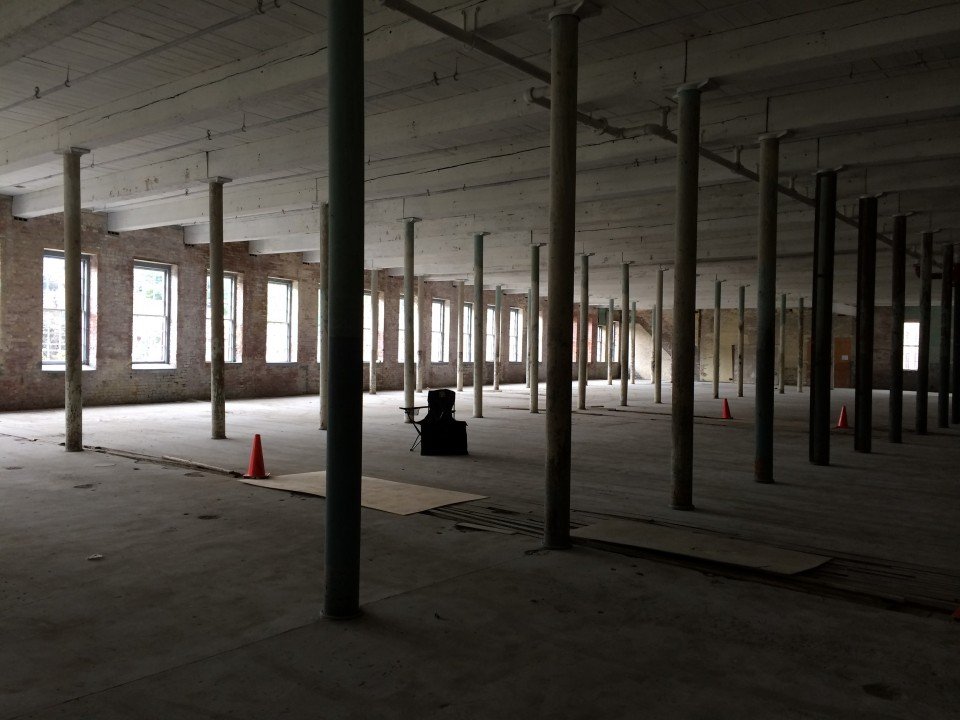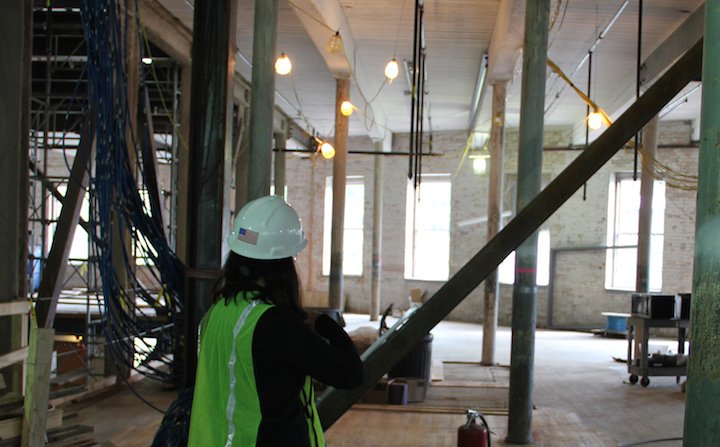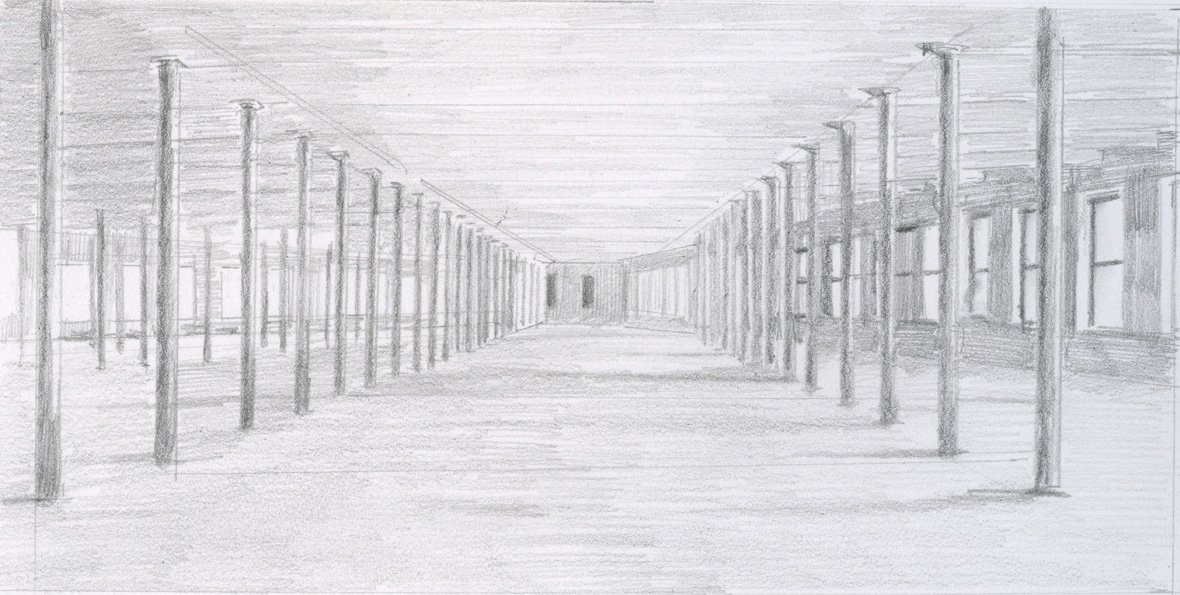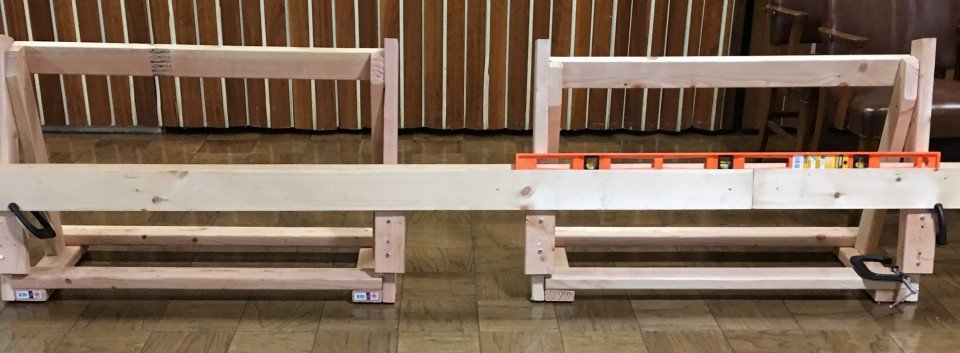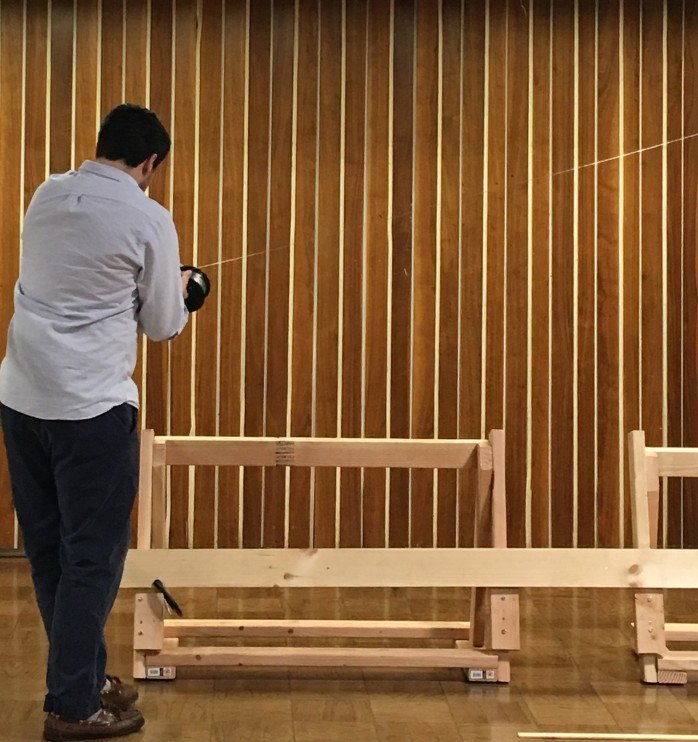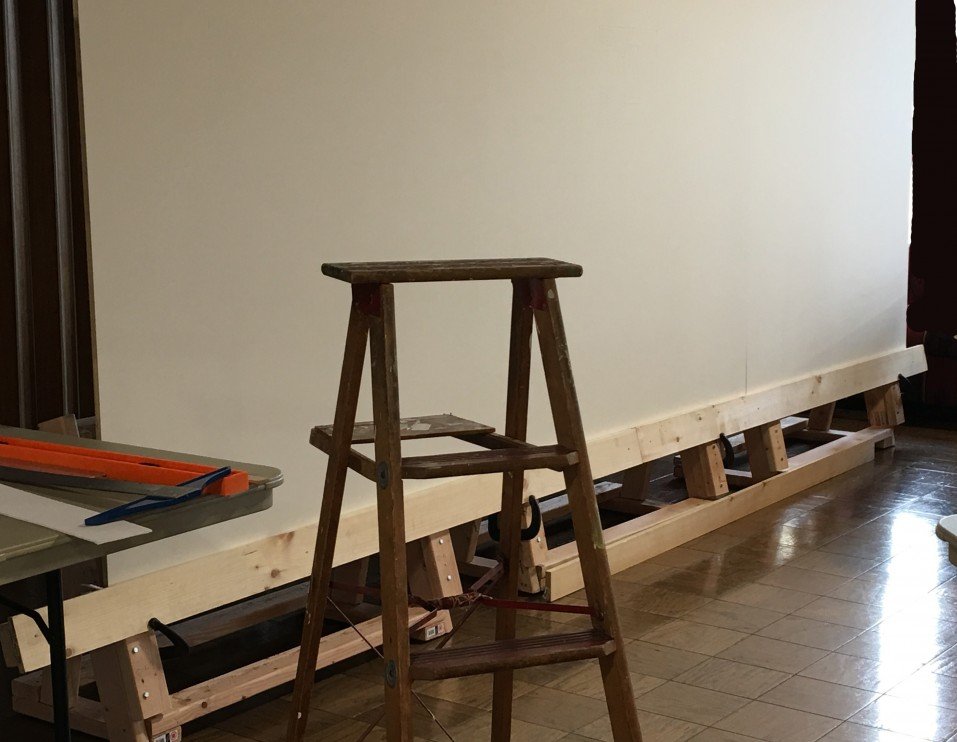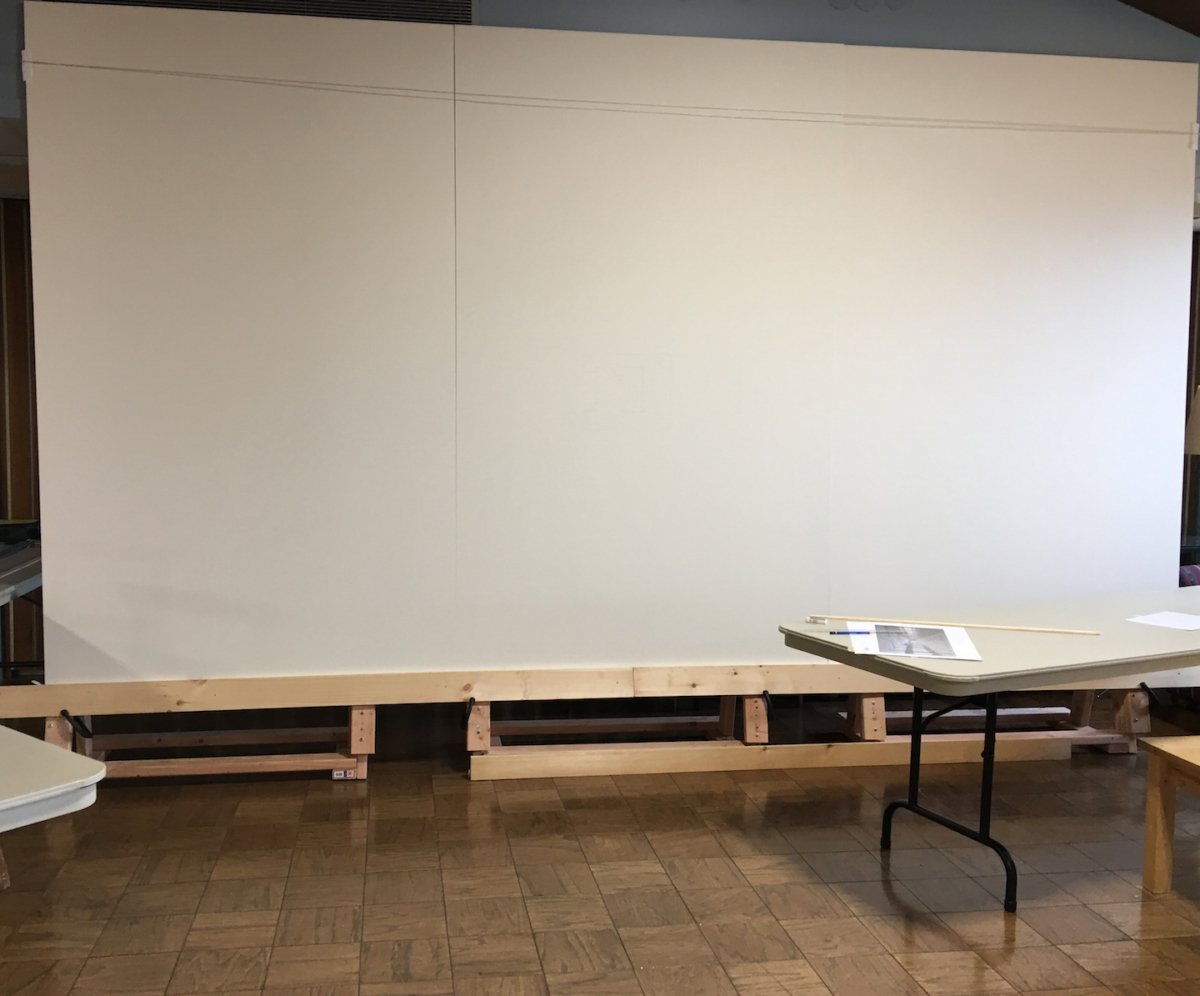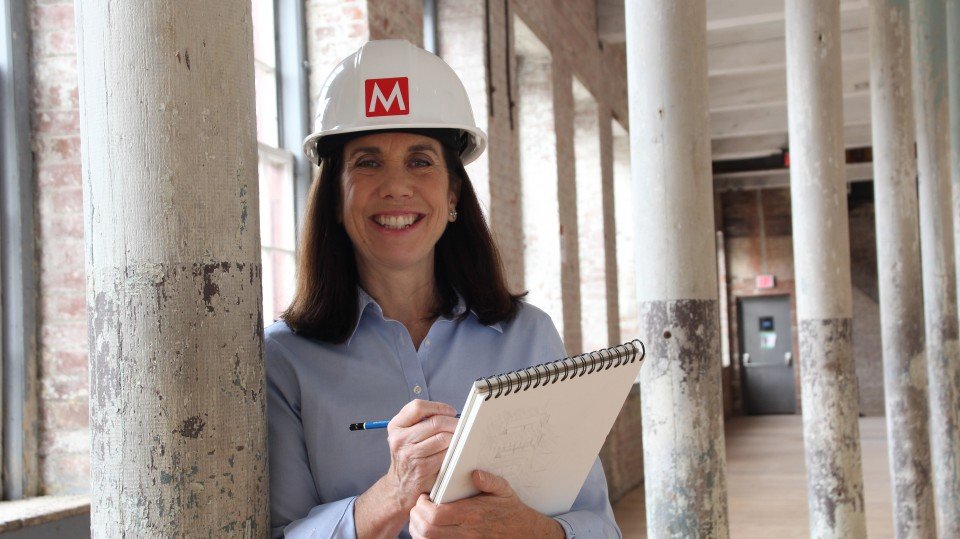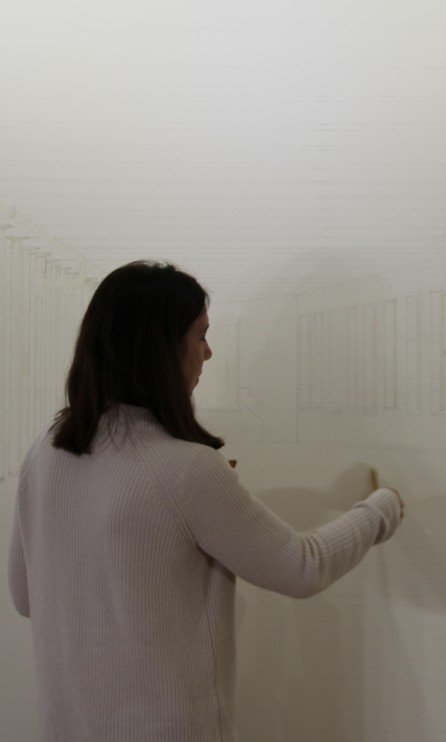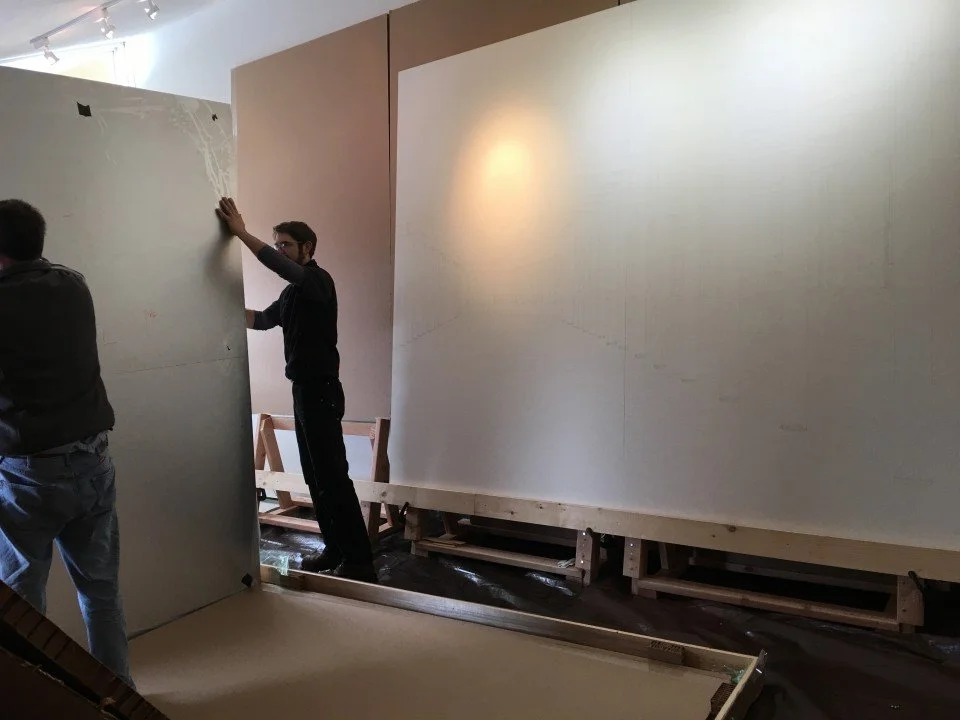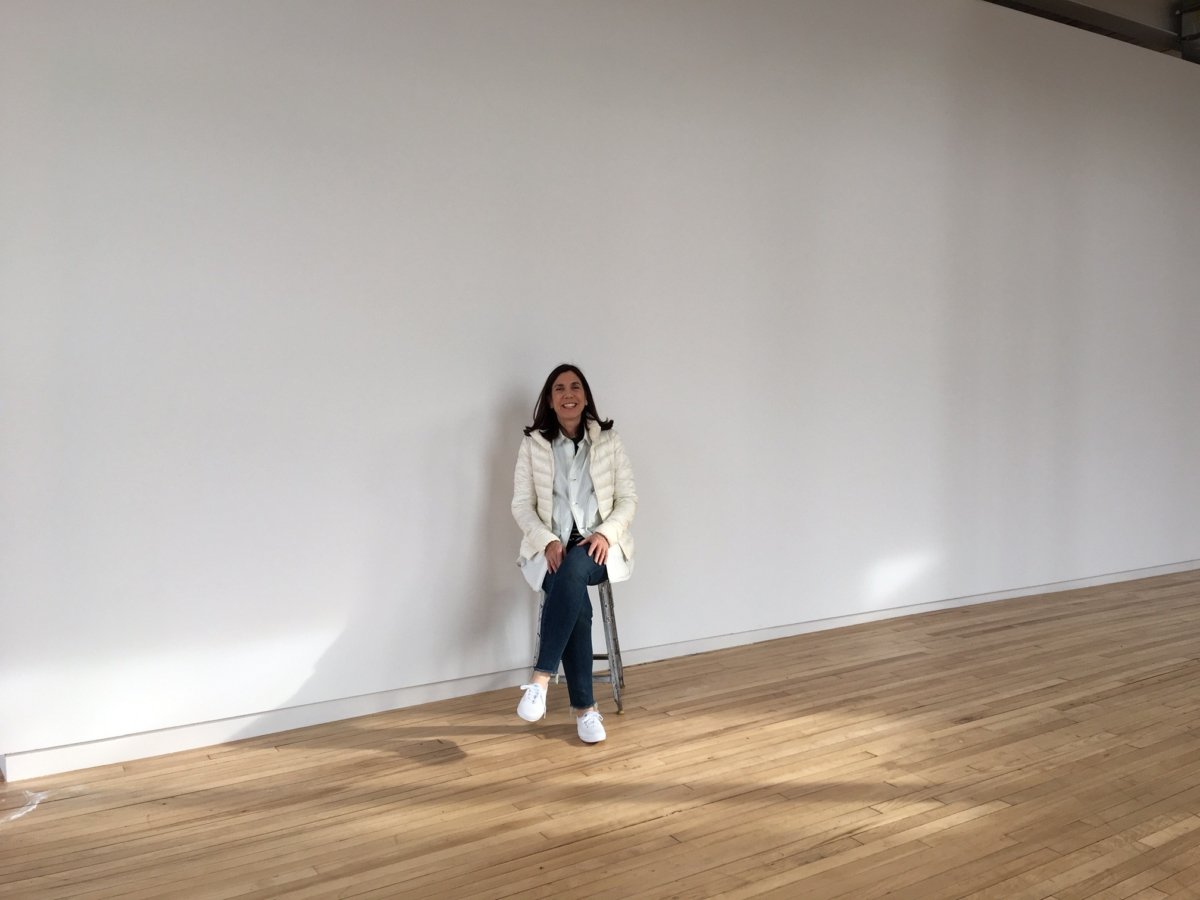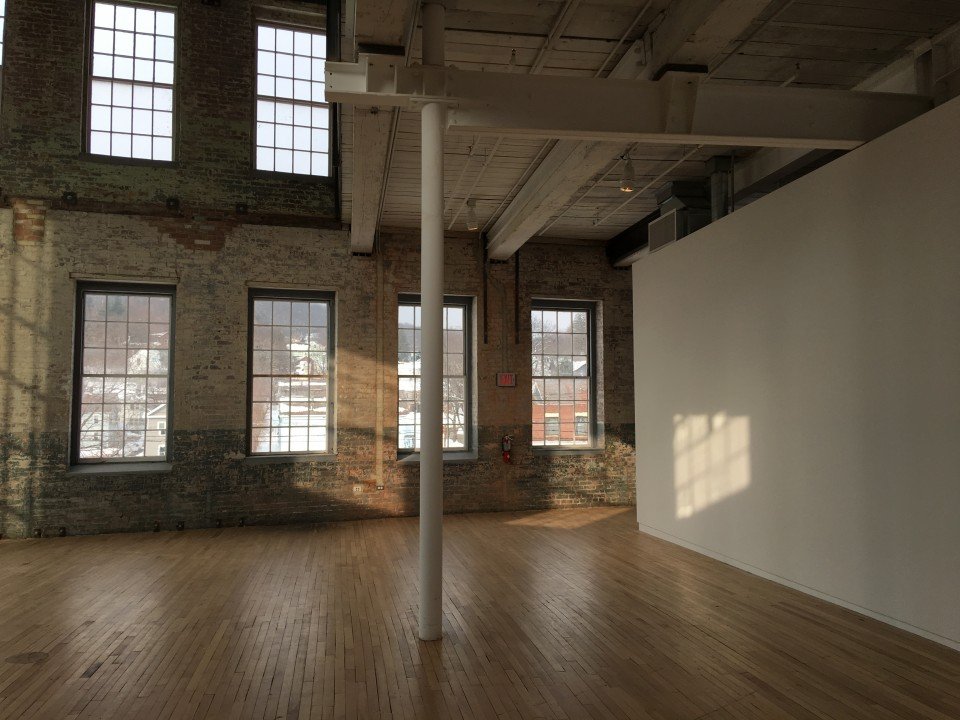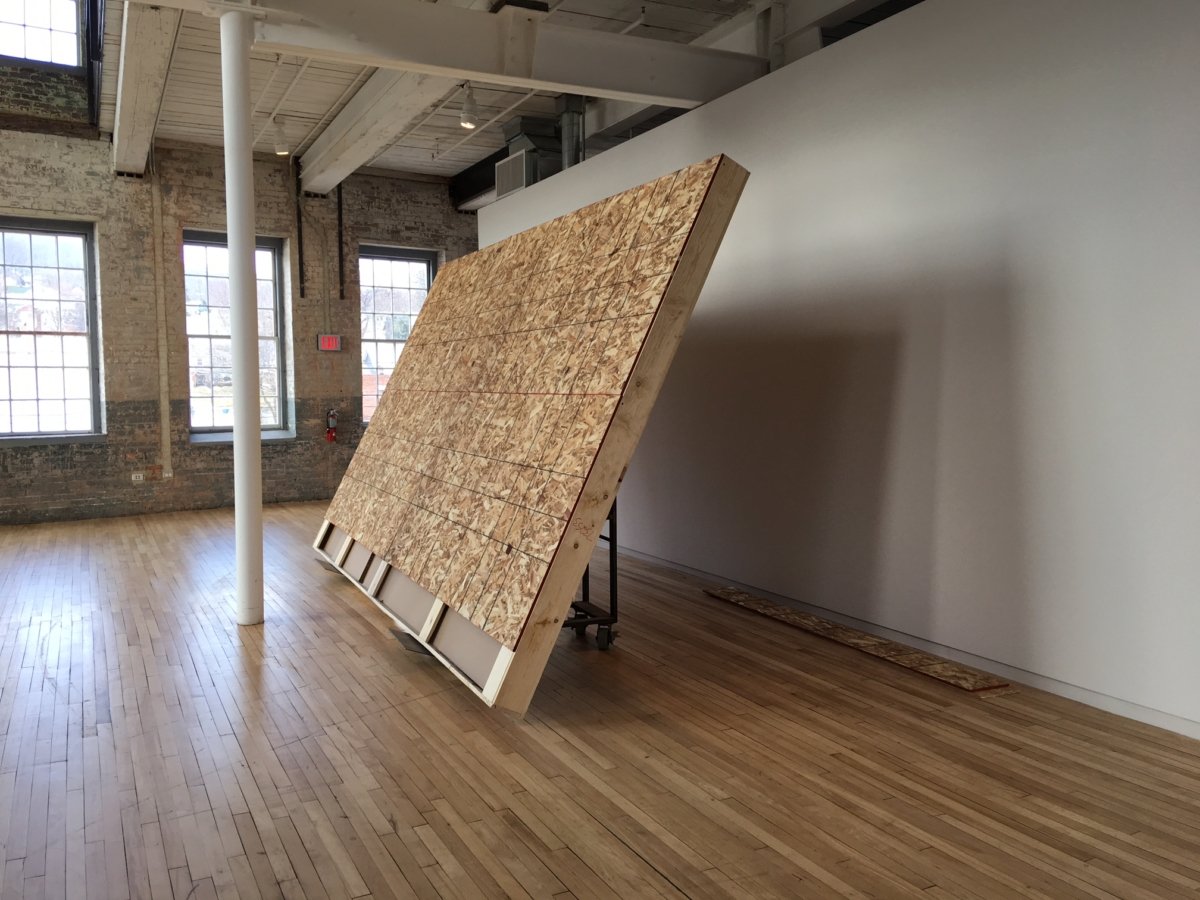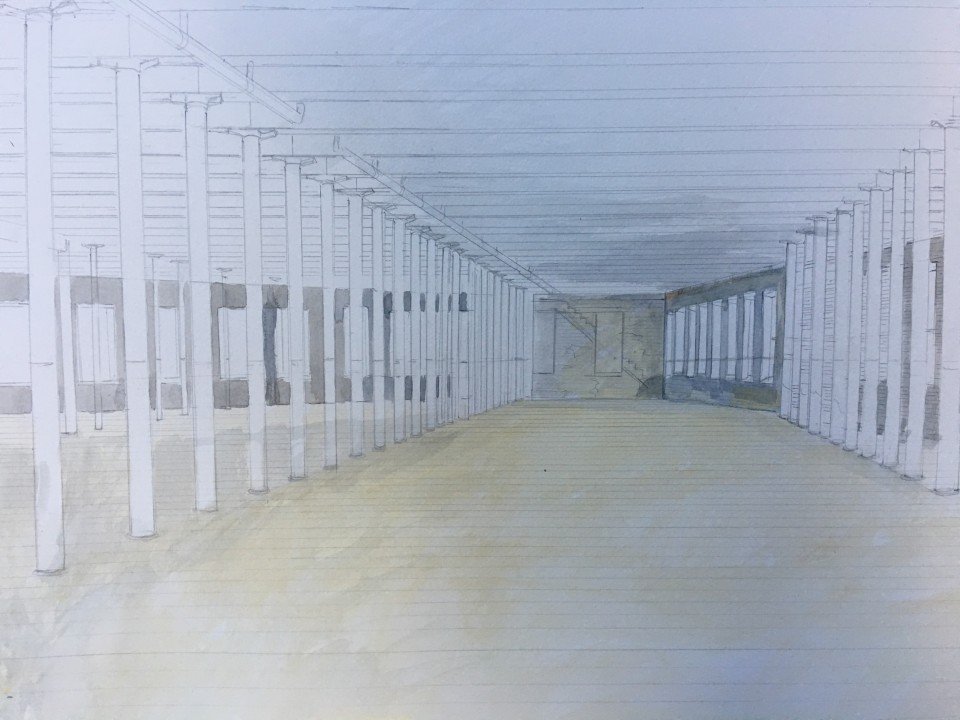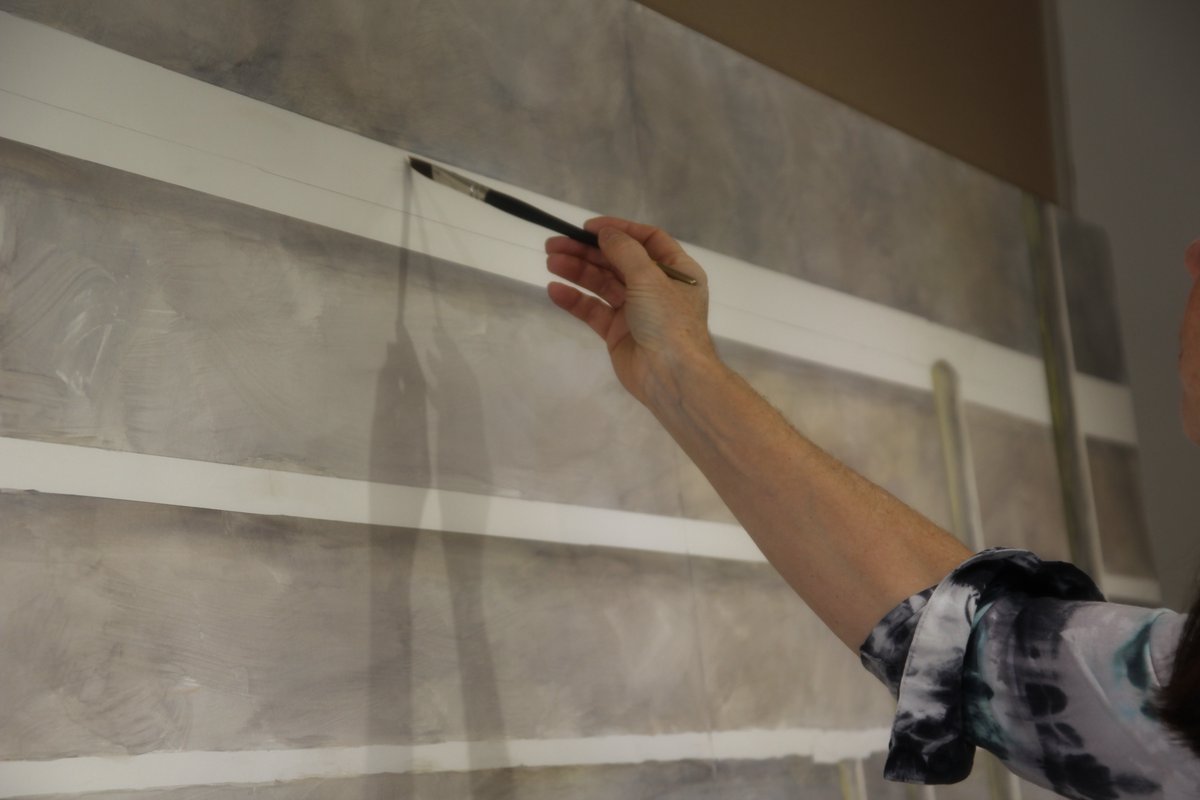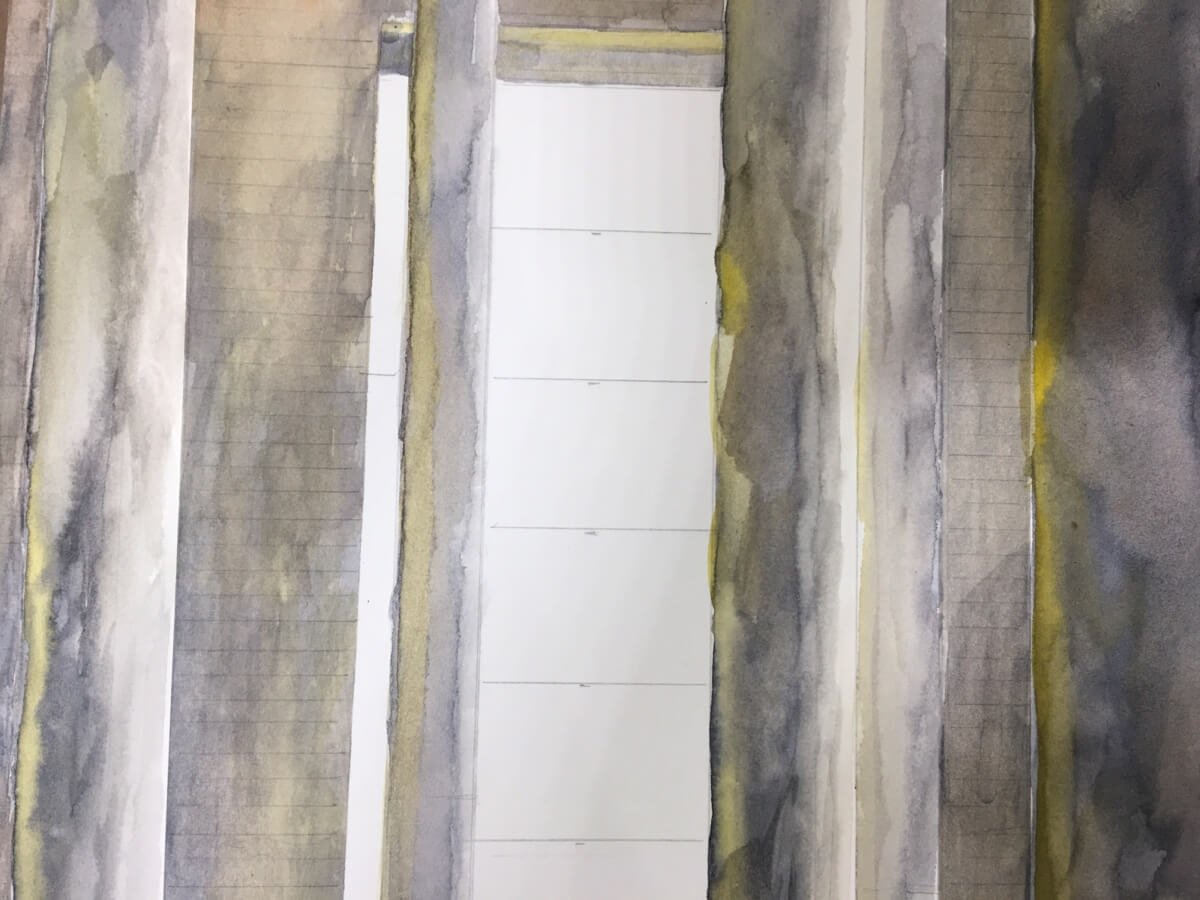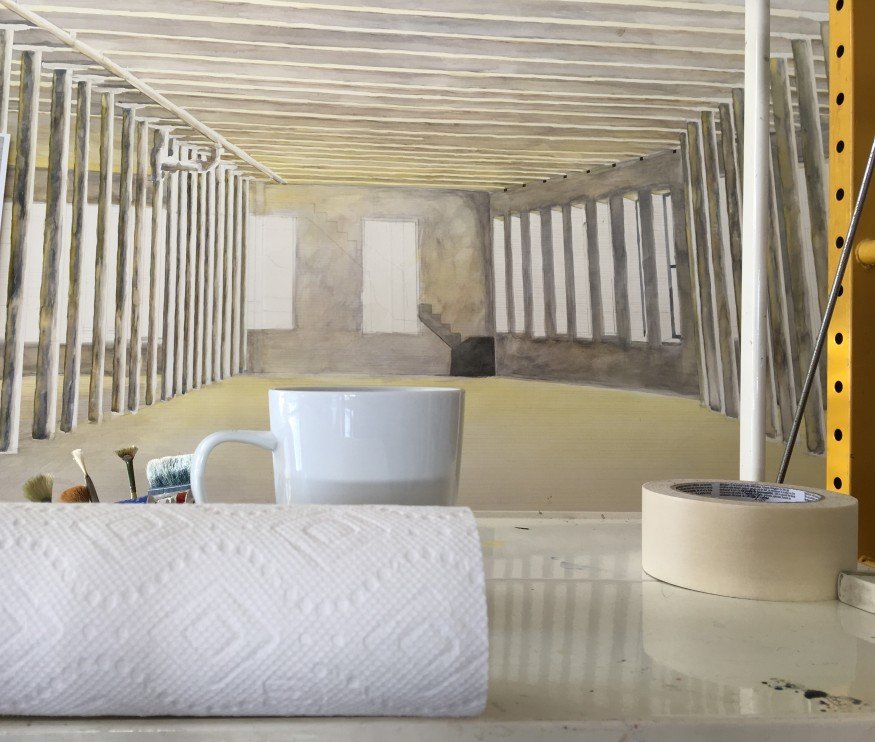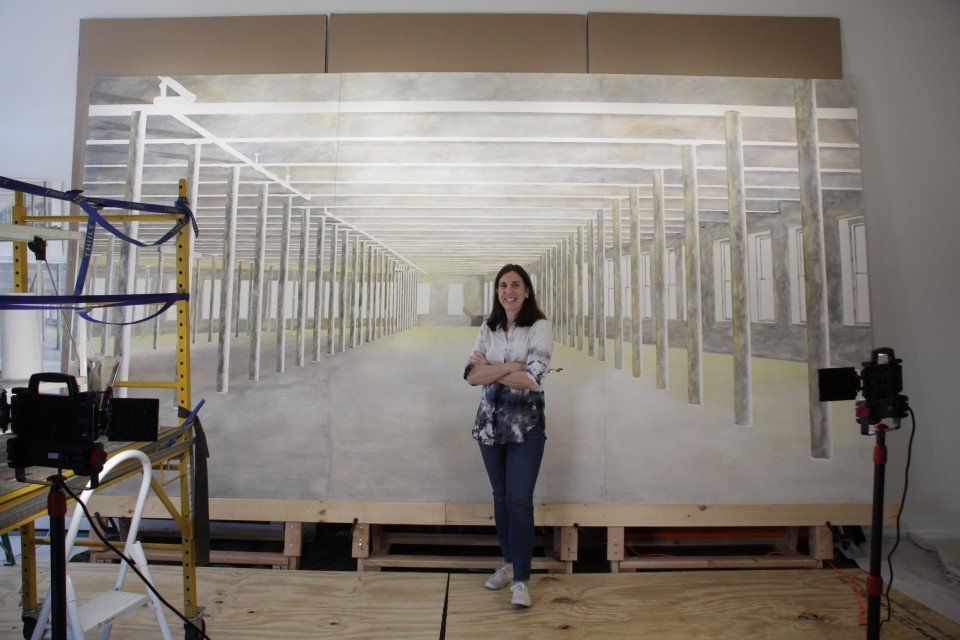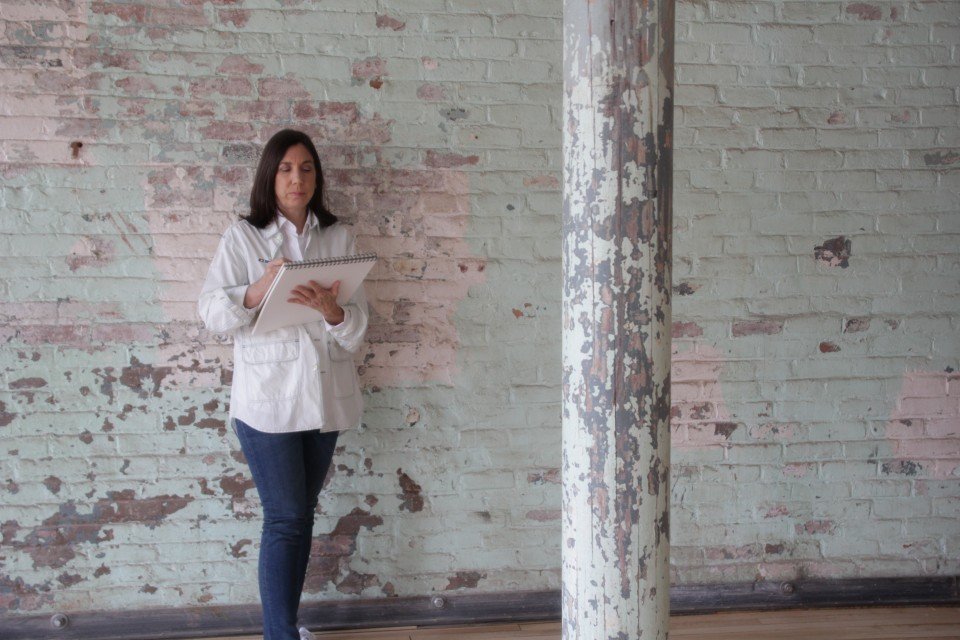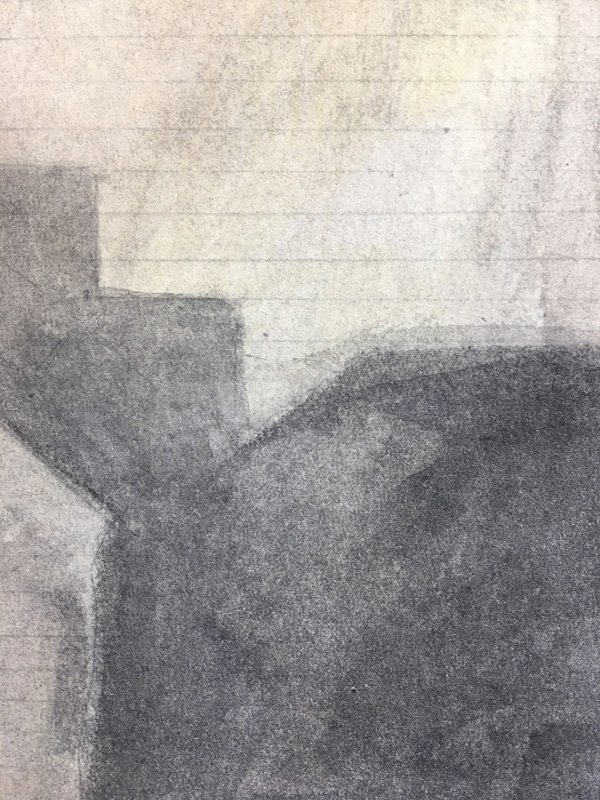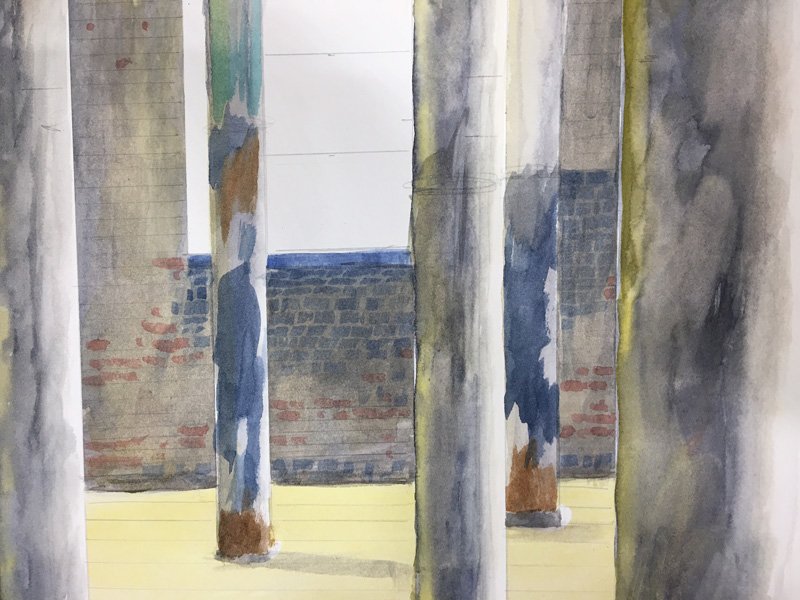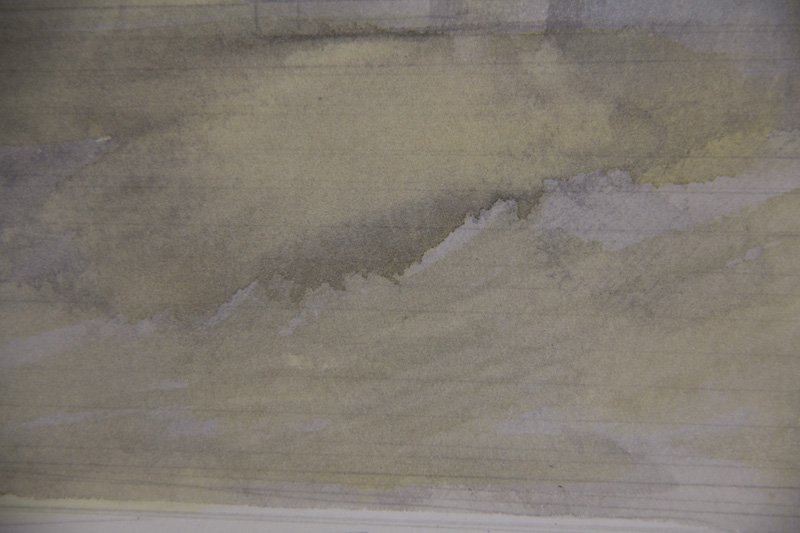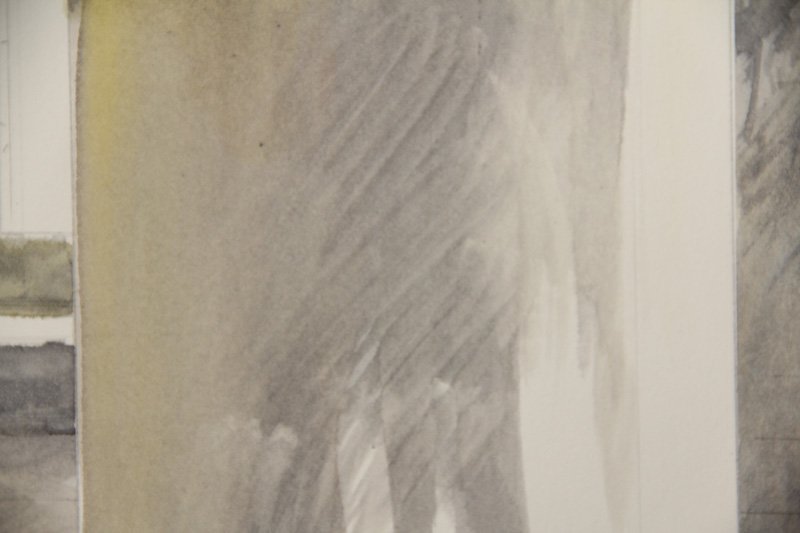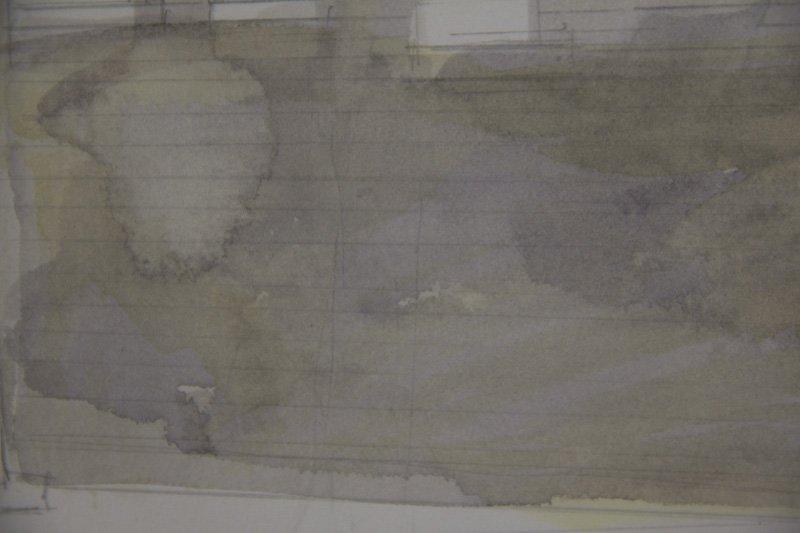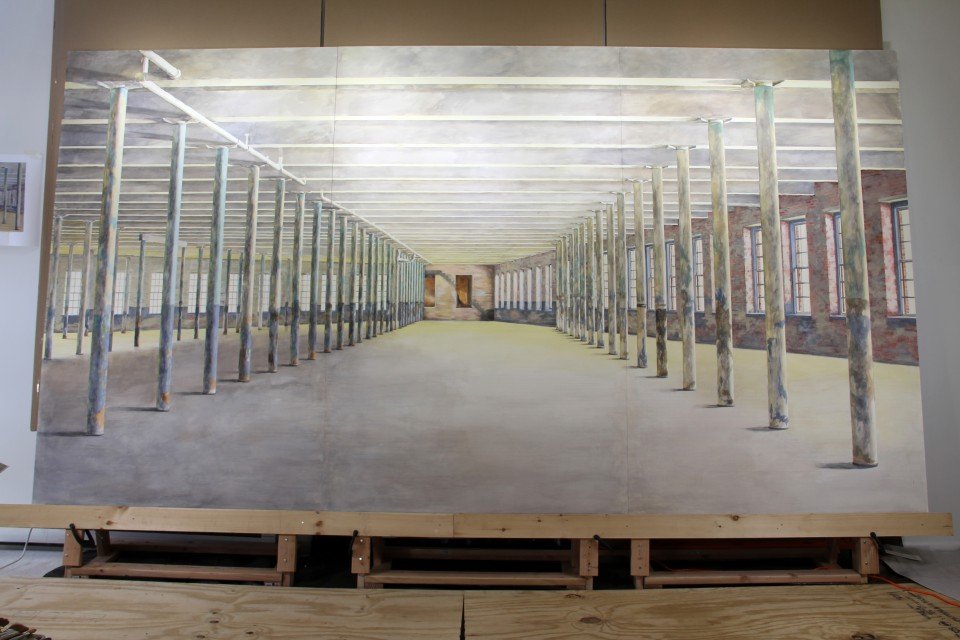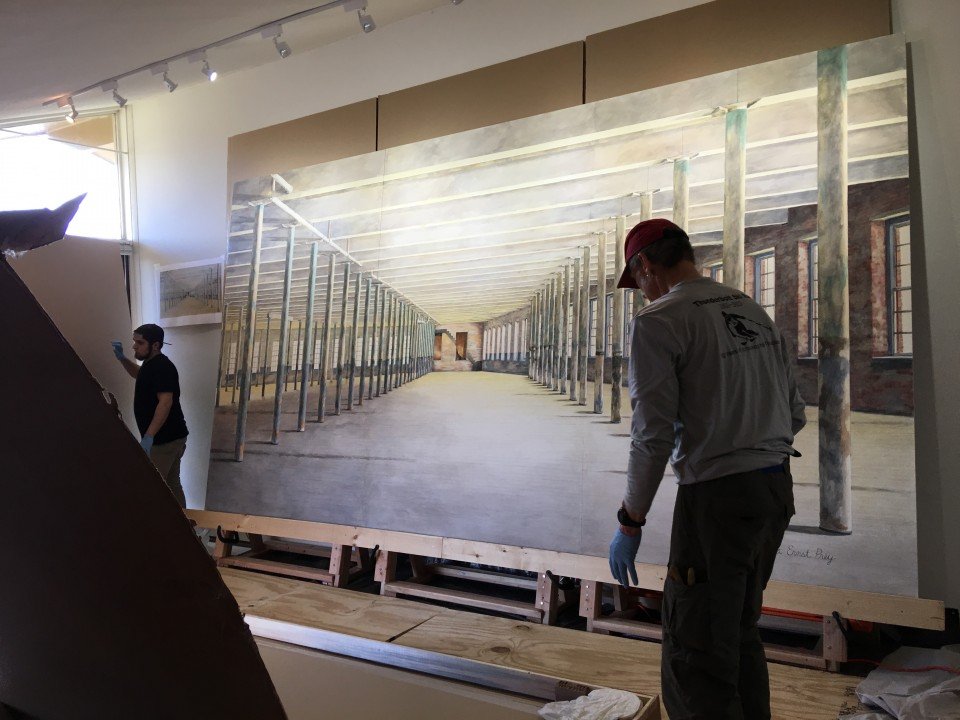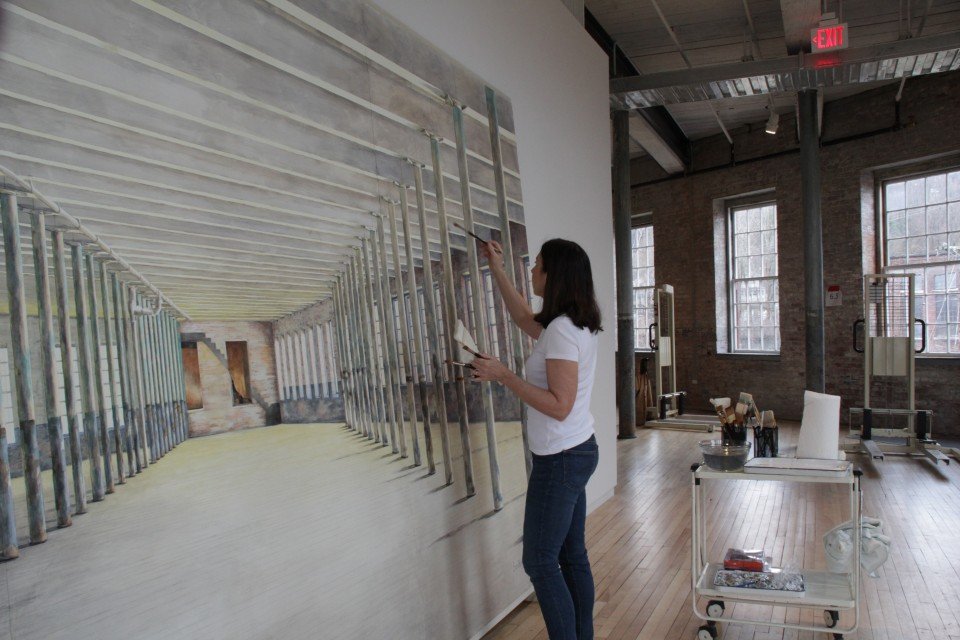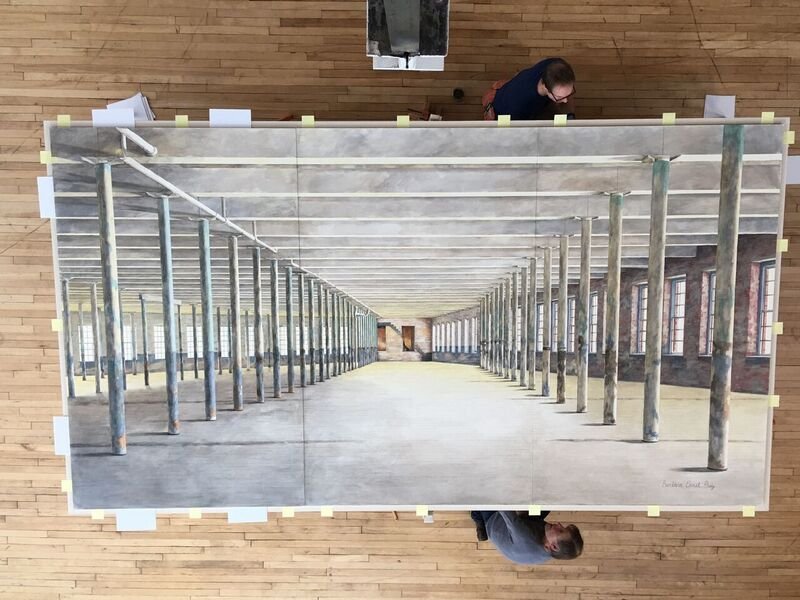MASS MoCA: Chronicle the Development of Barbara Prey’s Museum Commission
MASS MoCA’s Building 6 now open and Barbara’s painting — considered the world’s largest watercolor — on view, watch Barbara working on her commission onsite.
November 2016
Barbara has been commissioned by Massachusetts Museum of Contemporary Art (MASS MoCA) to paint a monumental watercolor for their new Building 6 to open on Memorial Day Weekend of 2017. With this new addition of over 120,000 square feet of exhibition space, MASS MoCA will be the largest contemporary art museum in the country.
The painting will be on exhibit longterm.
We chronicle the development of this project and continuously update this site.
Barbara Ernst Prey’s drawing pad and chair at MASS MoCA
Barbara drawing in the space at MASS MoCA
December 12, 2016
“I was fortunate to be able to spend a couple of months last fall, in the winter and spring drawing inside the building and trying to figure out the specific view that I would paint as the commission for MASS MoCA for the new space. I am honored to be the only artist commission for the new building which opens Memorial Day weekend 2017. I was able to bring my sketchbook and pencils and had to dress in layers because it was really cold there with no heat but it was a great time to draw and observe the space uninterrupted. I left a bit dusty – but loved being the only person in the building as I was able to go all through it up-and-down on the various floors and really get a sense of the history and the space/feel of the place. Here are some of the preliminary drawings.”
Pencil Study I
December 19, 2016
This is what the new addition to MASS MoCA looks from the outside. Barbara is working on an interior portrait of this building.
December 27, 2016
“I’ve spent a lot of time looking in thinking about the space, it’s the same way I approached my NASA work when I was commissioned by NASA to paint four paintings for their collection. I spent half a year just researching space and the international space station (including working with the director of the project) so that I would have an informed way of seeing before I began the project.
Color samples on paper
I’ve visited MASS MoCA often over the past year. One of the challenges of this museum commission is how to create a work of art in watercolor to this very large size, the final image will be 8’ x 16’. (I’ve contacted curators at MOMA and The National Gallery of Art and they aren’t aware of a watercolor painting this magnitude.) My first challenge was to find very large watercolor paper. I visited the art stores in New York City, called most of the well-known art supply stores in the U.S. and followed up with their leads to the various companies that produce paper in England, Spain, Italy and even Japan. I was sent samples to try out and narrowed it down to a couple of options that possibly could be large enough.”
January 12, 2017
Barbara working on the large size painting; she had to set it up in a bigger space close to her Oyster Bay, NY studio in order to fit the scale of the panels.
“I’ve had many conversations about how to actually produce this painting. The concept of perhaps the largest watercolor in the world 8’ x 15’ or maybe the largest painted by a living female artist sounds exciting but the behind the scenes process to even get to the beginning point was a zigzag of different trials and errors. (I do want to thank Frank Kelly, Deputy Director at the National Gallery of Art, Molly Donovan, Assistant Curator of Contemporary Art at the National Gallery of Art and Olga Visa, Director of the Walker Art Center for their initial help in formulating the project). I visited the Art Fairs (Art Basel, Art Show, Armory Show) to get ideas and see framing options. I am on the board of the Colonial Williamsburg Museums and they were very helpful directing me to appropriate curators who might help with paper questions, archival questions and framing (thanks to Pam Young in the paper department and Director Ron Hurst). Leslie Paisley at the Williamstown Conservation Lab was also helpful with initial paper questions. Joe Thompson, Director of MASS MoCA helped with initial concepts and placement as we looked at the plans for the then future museum renovation of Building 6 and where a painting of that size might fit in.”
January 26, 2017
STUDIES
“I spent all fall thinking about the project and doing studies of the space. I visited the space through out the year doing studies as the work developed. I worked first on pencil studies to be sure that I had the architecture accurate and to work out the light and darks of the space as well as the overall composition. A lot of time has been spent on the initial concept and process as the final large size is so enormous that I’d rather address the problems that might arise at the beginning. My work is often about memory and much is done on site/plein air but I make changes, move things around and create a very different interpretation and painting of what the subject might be. In this case the architecture needed to be accurate and reminded me of my studies with Lane Faison at Williams College. Lane was one of the deans of the Williams Art Mafia as well as a Monument Man (which is where I think he developed his love of Baroque and Rococco). My thesis was to be the first chapter of his book on Southern German Baroque and Rococo Art and Architecture and I spent many afternoons with Lane pouring over architectural drawings and interior photos to examine space. Because of Lane I continued my studies on a Fulbright Scholarship examining, drawing and looking at art and architecture in Europe. Interestingly, it was Lane who first brought me to see MASS MoCA. He wanted me to see the space, he was so excited about it. I remember going through the building with him before it opened so it is a nice circle to come back and now I paint a monumental painting of the new space. It has a very personal connection for me.
I also spent ten years doing artwork for The New Yorker, many with architectural themes as I always had my sketchbook while traveling. When I lived in New York City, I would go out and sit on a corner and draw. The MASS MoCA space, however, was a different type of line- not a whimsical, energy filled line but the lines of a strong architectural space with a history and connection to the community.”
Pencil Study II, 8.25 x 14 inches
February 2, 2017
Below is a concise quote from MASS MoCA that aptly summarizes my project for the museum:
“Barbara’s painting will be monumental by any standard, but for a watercolor on paper – perhaps the most unforgiving combination of any painterly media — the undertaking is truly breathtaking. Conceived as an interior portrait of MASS MoCA’s 120,000 square foot Building 6, the image will depict part of the historic mill in its raw, un-renovated state, just prior to the commencement of the construction work now underway, which will create long term exhibition galleries for the Robert Rauschenberg Foundation, Jenny Holzer, James Turrell, Laurie Anderson, and Louise Bourgeoise, among others.
Besides being an extremely large scale rendering of an extremely large and beautifully light-filled space, Barbara’s work is unique in other ways too. Deeply rooted in the traditional craft and practice of watercolor, the object will be a technical tour de force, requiring specially made papers, mounts and frames.”
Something not mentioned in MASS MoCA’s commission description of my painting is that this very large project is all done by hand, it is not mass produced or fabricated by somebody else as so much art is created today, but from the beginning drawings to the final painting, it is all done by my hand. As I’ve written in a previous post, I initially began with small studies working out the composition and value and, in this commission, choosing which view I would paint of the vast unrenovated space. I walked around the floors exploring different options and decided which section would make the most interesting painting. I like to work as much on site as possible, so after the pencil drawings (and I did many of them) I then moved to color studies. They began small as I was unsure of the saturation of the color and then I moved to larger studies. The last study is 32” x 40” which is tacked up on the wall as a reference for the final painting. I also made sure that I ordered the same watercolor paper that I was using for the final piece and tried working on the different weights as each piece has unique properties which affect the final outcome. Here are some of the studies which I worked out for most of Fall 2016.
Watercolor Study I, 8 x 15.5 inches
Watercolor Study II, 17 x 32 inches
Watercolor Study III, 17 x 32 inches
February 10, 2017
After I had done all the research, studies and ordered the paper, the next step was to figure out where I would execute such a monumental watercolor, a ‘tour de force’ as MASS MoCA Director Joe Thompson referred to it. Unfortunately, the large panels were 2 inches too large to fit through my studio windows (I had thought we could hoist them up to the top floor studio and through the windows) but I was fortunate to find a great location close by, a very large room in a local building which could easily accommodate the painting structures setup and with good light. I wanted the light to be as close to the MASS MoCA location as possible, the front wall of the museum’s new wing with two stories of windows and light so that the colors would be consistent. This could be different if the light source was dramatically different.
Much time was spent figuring out how to actually paint the painting, which included incorporating the build supports so that I would have access to the painting.
We had to figure out how to build the supports so that I would be able to paint the watercolor without the water-based paint dripping down the front of the painting, which would happen with a perpendicular surface. It took a bit of engineering to figure out how to get the painting perpendicular as possible, and with a bit of a lean, but not too much lean so I could still paint standing on the ladder and scaffolding. The supports needed to be flush and exact as there are many columns, windows and architectural details in the painting and I wanted to lines that were too slanted.
My invaluable assistant carried the awkward and heavy panels (very cautiously) from my studio to the ‘replacement’ studio and assembled the support structure. As through this whole process so far I have had a wonderful support team. The scaffolding arrived, ladders were purchased and everything was set for the initial pencil drawing on paper.
Setting up the easels
Installing the panels
All set up, ready to paint
February 14, 2017
THE DRAWING
The next challenge was how to transfer my preliminary drawings onto the very large surface. I had done many pencil studies and watercolor studies so I had an idea what the final painting would look like, but they had all been worked out on a much smaller scale. It was daunting to draw on such a large scale and I needed enough space so that I could step back and view the drawing in progress for final corrections and overall development. I had to make sure that, as it was architectural, the columns were straight and that both the vertical and horizontal lines of the building were somewhat straight (although there was sagging). I had no idea how long the pencil drawing would take, and, as it turned out, it took a very long time. I had ordered an extra long straight edge ruler and then rigged one on my own which came in handy to make sure everything matched up. It took me well over a month to finish the drawing– making sure that all the lines were correctly drawn. I also have to be very cautious with watercolor paper because any damage to the surface of the paper, for example excessive erasing, will affect the finished watercolor as the pigment will puddle in the damaged surface.
Pencil Study, 8.25 x 14 inches
The large panels set up at the studio
SUPPLIES
Drawing in the space at MASS MoCA
Drawing on the big surface at the studio
As I’ve written, I’d spent a lot of time thinking about how to execute the painting, which included what supplies I would need to augment what I already have. I visited the art stores in New York City, looking at art catalogs online and researching the brushes that would be most appropriate to use for the painting. As there is so much surface space, if I used my smaller watercolor brushes the painting would take forever. There are different brushes used for oils than watercolors. I paint in both mediums so I have quite a collection of brushes in my studio, but none were appropriate. I settled on some large Japanese brushes and ordered new brushes that I had never used before, hoping that they would prove to be good and for me, easy to handle. With larger brushes came the need to find a larger mixing space as well as larger buckets for water and more paint. I would need a ladder, a stepstool and some sort of scaffolding so that I could get up high on the painting to paint. From the start, this was all about exploring uncharted territory but perhaps the most important thing to remember was that I really couldn’t make a mistake – which is the scary part about watercolor.
February 21, 2017
MOVING THE PAINTING TO WILLIAMSTOWN
Although I had a large space to work on the painting close by my New York studio which provided a great location to execute the drawing and was convenient, I missed the natural light and so made the decision to move the painting to my studio in Williamstown, Massachusetts. This would allow me to make frequent trips to MASS MoCA to double check Buildling 6 while working on the painting. I also had ample space to step back and view the painting from a distance, which I often do.
The move to Williamstown was a bit problematic as we had already built the supports and moving the work could damage the paper surface- but again I was fortunate to have some good art handlers to help with the move. Everything was repacked and moved by a large truck to Williamstown. The MASS MoCA staff were on hand to help unload and move the painting into the new studio space. This was no small feat, but they were able to move the panels up the back stairs and into the studio space. They then unpacked and reassembled the structure, supports, and artwork and I was all set up to paint. I continued to make some final adjustments to the drawing as it is the roadmap for the painting. The lighting in the studio neede adjustment and we tried to make it as similar to the daylight in the gallery space at MASS MoCA where the painting would eventually hang. The studio space has high ceilings and windows with lots of light which also look out on the Berkshire mountains- looking towards MASS MoCA. For the most part the weather has been part overcast or snowing which is perfect for me as there are no strong light shadows coming across the painting from the windows.
On the way to the back stairs
Setting up
March 7, 2017
FRAMING
Much thought went into finding a framer and figuring out the best way to frame such a large painting. Leslie Paley, an expert on works on paper at the Williamstown Conservation Lab was my initial contact and very helpful. I also asked my contacts at the Colonial Williamsburg Foundation Museums as they also have a top-notch paper conservation department. I concurrently visited a number frame shops in New York City to hear their suggestions for framing such a large piece. Some were unable to take on the project, as it would consume too much space in their workshop. One of the project’s supporters suggested I work with the Williamstown Conservation Lab (WACC) and have them construct the frame as the wood/furniture conservator is very knowledgeable. That made sense as WACC is around the corner from my studio and five minutes from MASS MoCA and makes the delivery and assembly of the painting, as well as the delivery to MASS MoCA, more practical. They are now beginning on the frame.
In front of the wall where the large watercolor will be on display.
Another view of “my” wall to the right
One of the challenges of such a large watercolor is finding the appropriate glazing. As glass would be too heavy, we selected museum quality acrylic glazing. WACC will assembly the final frame in house, building a travel frame so they can move the painting to MASS MoCA and do the final assembling at the museum. I’ve been waiting to decide the stain of the wood frame as I’m not quite finished with the painting and want a stain that will augment the overall tone of the painting. MASS MoCA provided a digital mockup of the painting on the wall, which is exciting to see. The painting will hang in the front of the new building, at the prow as it is called, with two open stories and space so that the painting can be viewed from a distance, it does need about 30 feet distance to take in the monumentality of the full painting.
And here comes the frame, protected in a crate
March 14, 2017
ARCHITECTURE AND MEMORY
The history of MASS MoCA’s architecture is characterized by over 200 years of change. Originally housing small scale industries, the 16 acres of grounds were transformed into a textile printing mill in the 1860s and most of the present-day buildings were constructed in the period between 1860 and 1890. From 1942-1985, before restructuring the complex into a contemporary art center, the site was the home of Sprague Electric largely leaving the exterior of the buildings untouched.
Opening its doors in 1999, MASS MoCA’s first 2 phases of construction were led by Massachusetts based architects Bruner / Cott & Associates as is this final Phase III expansion with the unveiling of building 6; the building that will house my massive watercolor depicting an interior portrait of the space in its raw state before the renovation.
Sprague Electric was still in North Adams when I attended Williams College and I’ve watched the transformation of the museum over the many years. They made ceramics for NASA used in some of the space flights. There is a wonderful connection as I’ve been commissioned by NASA four times to paint paintings of the space program. I was working on the museum last week and Laurie Anderson was also there working on her project. We were the only two artists commissioned by NASA one year so how interesting that we are both commissioned by MASS MoCA in a building which built products for NASA (and around the corner from me is Robert Rauschenberg’s work, another NASA artist).
I have had the unique experience with this commission to spend time in a space that is constantly changing. I often take my paints and sketchbook while working on the painting and work in the space which are my notes that I bring back to my studio to work on the painting. I’ve watched as my part has slowly disappeared and been transformed, the floor is cleaned up, the walls are put in and some of my columns are missing. There are still parts of the original space which have provided references for what was and I have my memory and impressions of the original space which is what I am painting.
Early Watercolor Study
Watercolor Column Study, 7.75 x 10 inches
March 21, 2017
BEGINNING TO PAINT
After months of preparation and thinking about the project it is finally time to paint. I have to admit there’s a sense of fear when looking at this 8 x 15 sheet of watercolor paper and hoping that I don’t make a mistake as watercolor is a very unforgiving medium. I am hoping that in the end the painting will be a “tour de force” as MASS MoCA describes the work on their website.
High up painting
Starting to apply paint
I wasn’t quite sure where to start so I began with the background using my very large 4 to 6 inch brushes. It was really fun to paint such a large surface area and reminded me of finger painting as a child – I often incorporate my hand and fingers on the surface so that I can move the paint around which create spontaneous abstractions and interesting patterns as well as unique marks on paper. It’s a tactile aspect to the painting and something I am particularly fond of with watercolor. Not only am I using wonderfully soft brushes when I paint but my hand glides over the paper so I have direct contact with the painting. Some of this first pass will be painted over, sad to say.
Detail
My studio is very close to MASS MoCA so I am able to go back and forth and look at the space if I have any questions about color or composition.
Studio view
March 28, 2017
CONTINUING TO PAINT
I’ve begun the final painting and have most of the surface covered with my initial wash. When it is finished it will have many layers of color and washes. I particularly like the marks on the paper and color shifts in the underpainting and think I will keep much of it through to the end of the painting. As the original space was covered in dust and quite raw I am trying to keep that sense in the painting. Watercolor offers a transparency not available in oil paints so the challenge is to keep some of the white of the paper without overpainting because you can’t go back and erase, once the color is down in watercolor it is very difficult (if impossible) to remove. I am incorporating parts of the building into the painting, dirt mixed in with the paints and color chips from the columns used in painting the columns in the painting. I continue to make trips back and forth to MASS MoCA when I have questions about the architecture, interior space and colors of the bricks and columns as there are many years of color layers on both. Sprague Electric had a full time painter on hand who continually painted the building interior. The many layers of the painted columns and walls have peeled off over time creating a unique color palette.
April 4, 2017
DETAILS
As it is such a large painting, it is best seen from the front of the museum which is about 30 feet away. The painting, however, is composed of many details which on their own are quite abstract and loose. The details, when seen on their own, could be mistaken for abstract paintings. Here are a couple that I have so far.
August 24, 2017
Detail
I’ve included details because the painting is really about what happens between the lines. It took a long time to draw out the original drawing. The lines give it the structure and architectural definition and create the story, a sort of skeleton. The drawing is really important but what happens between the lines is the story. It is layers and layers of color, color being pushed, and mixing color with part of the building fragments, with dust, and with paint chips. It’s about fingermarks, paint lines and color washes. Watercolor is a tough medium as it dries quickly, creating hard edges so it’s important to be fluid and flexible. There alot of energy and movement involved in painting such a large painting – creating a sort of abstraction. It’s tricky as you don’t want the passage you are currently working on to dry without being finished but to flow into the next passage. I also have to be careful that the wet paint doesn’t drop down the front of the painting in all of my back back-and-forth and up-and-down (ladder and scaffolding). I’m drawn to the details of the painting because they are immediate responses to the subject and intimate marks on the surface of the paper.
The finished painting in my studio
Getting ready to move the painting from my studio to MASS MoCA
Something else of note is that the entire painting is by my hand, no studio assistant to fill in the color. I was involved in all aspects of the process. To me every part of the painting is a decision or problem to solve and I am intimately involved with the process.
One of the challenges of the painting was that everything was bumped up – from the size of the paper, to the brushes, to even the size of my water container. I purchased a number of new brushes and was unsure how they would work as they were large and unwieldy. The pigment had the chance to globe on the brush creating streaks across the paper. There was also more room with a larger brush for drippage down the front of the painting. As I’ve been painting watercolor for so many years much is second nature to me but there was a steep learning curve with the brushes.
At MASS MoCA, the painting is ready to go up on the wall
Finishing touches
Framing the painting was another problem to solve. As I mentioned I met with a number of recommended framers in New York City. The finished painting weighed 300 pounds and it took seven people to install- with an incredibly large sheet of glazing. Eventually, The Williamstown Conservation Lab made the frame, and then we installed the artwork into the frame on site at MASS MoCA. Curator Susan Cross and I watched as it was mounted on the wall.
The painting gets prepared to be placed into the frame.
Framing process at MASS MoCA

